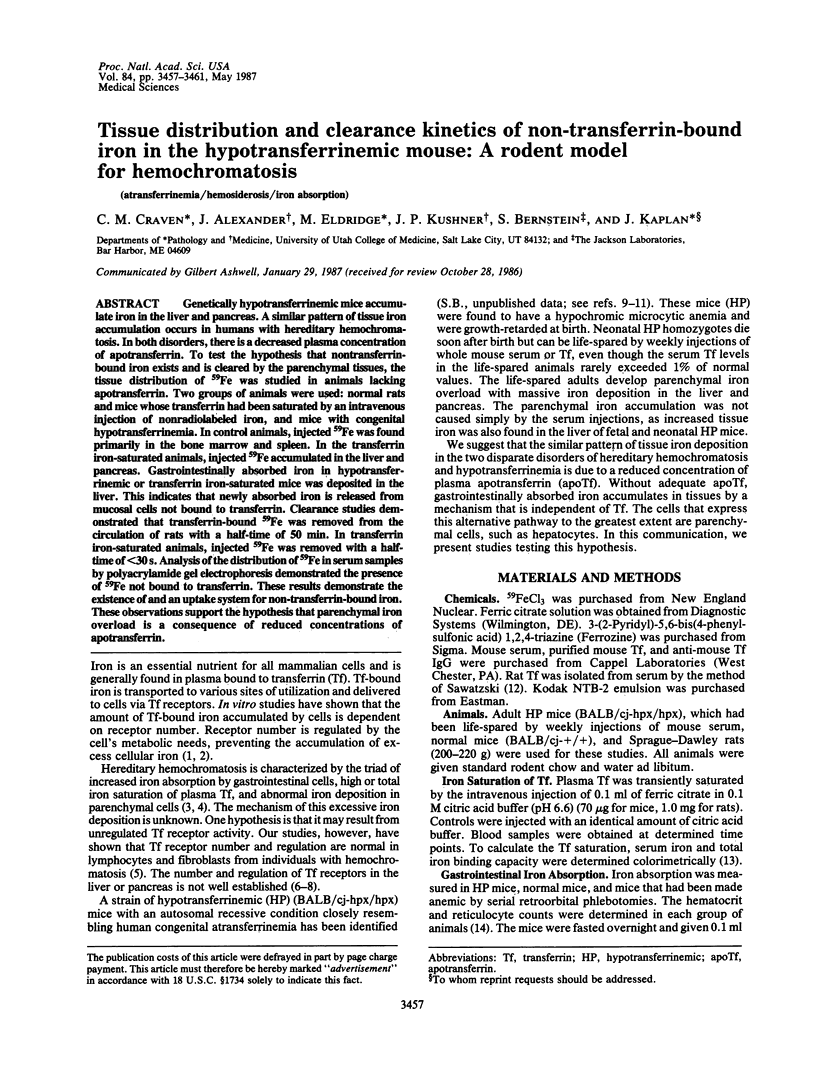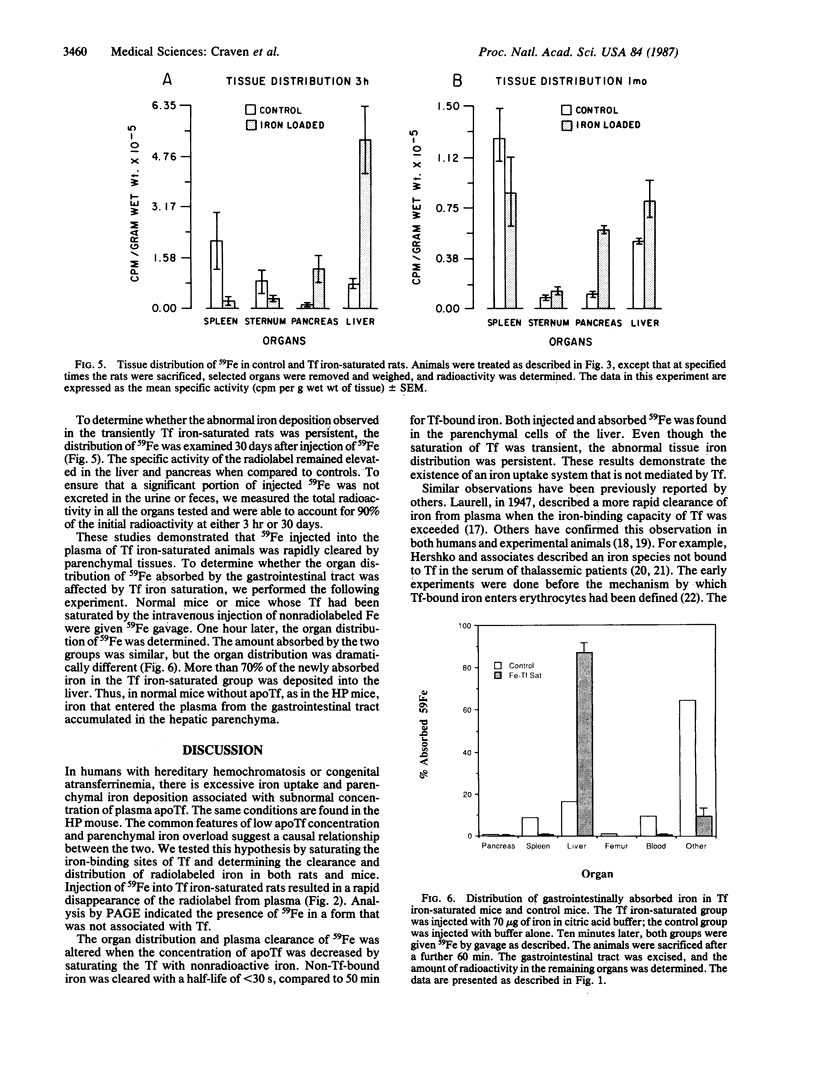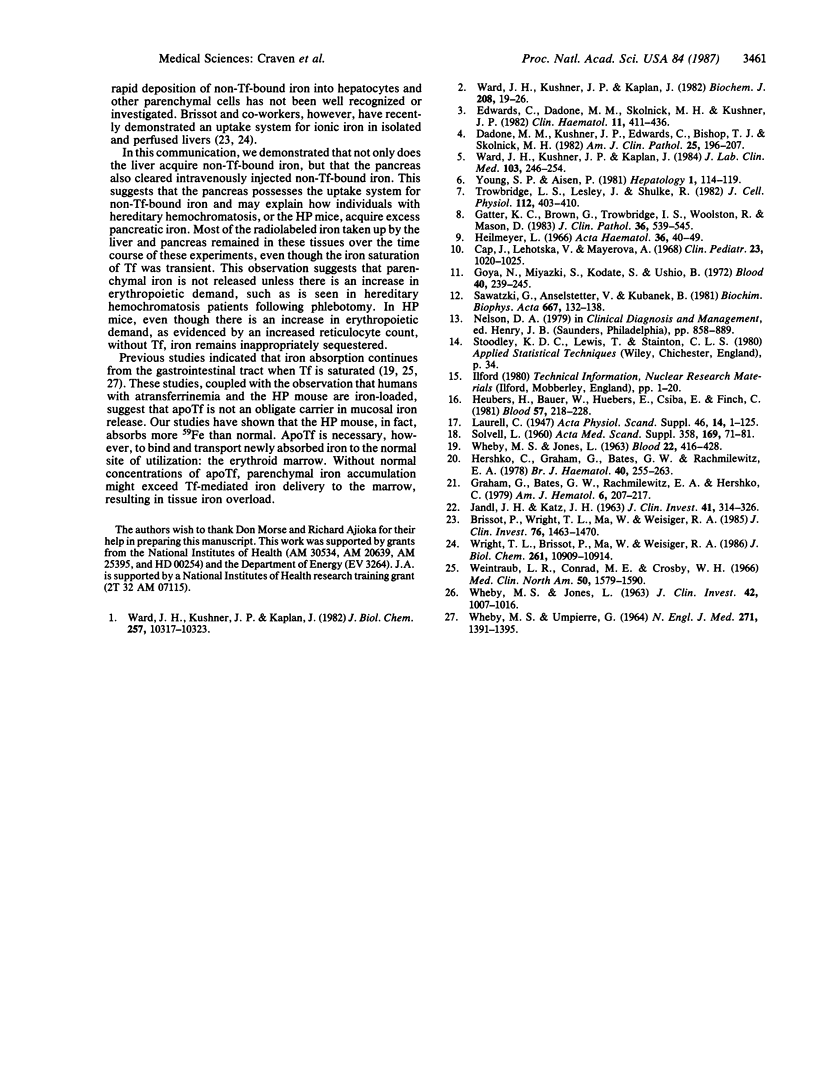Abstract
Genetically hypotransferrinemic mice accumulate iron in the liver and pancreas. A similar pattern of tissue iron accumulation occurs in humans with hereditary hemochromatosis. In both disorders, there is a decreased plasma concentration of apotransferrin. To test the hypothesis that nontransferrin-bound iron exists and is cleared by the parenchymal tissues, the tissue distribution of 59Fe was studied in animals lacking apotransferrin. Two groups of animals were used: normal rats and mice whose transferrin had been saturated by an intravenous injection of nonradiolabeled iron, and mice with congenital hypotransferrinemia. In control animals, injected 59Fe was found primarily in the bone marrow and spleen. In the transferrin iron-saturated animals, injected 59Fe accumulated in the liver and pancreas. Gastrointestinally absorbed iron in hypotransferrinemic or transferrin iron-saturated mice was deposited in the liver. This indicates that newly absorbed iron is released from mucosal cells not bound to transferrin. Clearance studies demonstrated that transferrin-bound 59Fe was removed from the circulation of rats with a half-time of 50 min. In transferrin iron-saturated animals, injected 59Fe was removed with a half-time of less than 30 s. Analysis of the distribution of 59Fe in serum samples by polyacrylamide gel electrophoresis demonstrated the presence of 59Fe not bound to transferrin. These results demonstrate the existence of and an uptake system for non-transferrin-bound iron. These observations support the hypothesis that parenchymal iron overload is a consequence of reduced concentrations of apotransferrin.
Full text
PDF




Images in this article
Selected References
These references are in PubMed. This may not be the complete list of references from this article.
- Brissot P., Wright T. L., Ma W. L., Weisiger R. A. Efficient clearance of non-transferrin-bound iron by rat liver. Implications for hepatic iron loading in iron overload states. J Clin Invest. 1985 Oct;76(4):1463–1470. doi: 10.1172/JCI112125. [DOI] [PMC free article] [PubMed] [Google Scholar]
- Cáp J., Lehotská V., Mayerová A. Kongenitálna atransferinémia u 11-mesacného dietata. Cesk Pediatr. 1968 Oct;23(11):1020–1025. [PubMed] [Google Scholar]
- Dadone M. M., Kushner J. P., Edwards C. Q., Bishop D. T., Skolnick M. H. Hereditary hemochromatosis. Analysis of laboratory expression of the disease by genotype in 18 pedigrees. Am J Clin Pathol. 1982 Aug;78(2):196–207. doi: 10.1093/ajcp/78.2.196. [DOI] [PubMed] [Google Scholar]
- Edwards C. Q., Dadone M. M., Skolnick M. H., Kushner J. P. Hereditary haemochromatosis. Clin Haematol. 1982 Jun;11(2):411–435. [PubMed] [Google Scholar]
- Gatter K. C., Brown G., Trowbridge I. S., Woolston R. E., Mason D. Y. Transferrin receptors in human tissues: their distribution and possible clinical relevance. J Clin Pathol. 1983 May;36(5):539–545. doi: 10.1136/jcp.36.5.539. [DOI] [PMC free article] [PubMed] [Google Scholar]
- Goya N., Miyazaki S., Kodate S., Ushio B. A family of congenital atransferrinemia. Blood. 1972 Aug;40(2):239–245. [PubMed] [Google Scholar]
- Graham G., Bates G. W., Rachmilewitz E. A., Hershko C. Nonspecific serum iron in thalassemia: quantitation and chemical reactivity. Am J Hematol. 1979;6(3):207–217. doi: 10.1002/ajh.2830060305. [DOI] [PubMed] [Google Scholar]
- Heilmeyer L. Die Atransferrinämien. Acta Haematol. 1966;36(1):40–49. doi: 10.1159/000209090. [DOI] [PubMed] [Google Scholar]
- Hershko C., Graham G., Bates G. W., Rachmilewitz E. A. Non-specific serum iron in thalassaemia: an abnormal serum iron fraction of potential toxicity. Br J Haematol. 1978 Oct;40(2):255–263. doi: 10.1111/j.1365-2141.1978.tb03662.x. [DOI] [PubMed] [Google Scholar]
- Huebers H., Bauer W., Huebers E., Csiba E., Finch C. The behavior of transferrin iron in the rat. Blood. 1981 Feb;57(2):218–228. [PubMed] [Google Scholar]
- JANDL J. H., KATZ J. H. The plasma-to-cell cycle of transferrin. J Clin Invest. 1963 Mar;42:314–326. doi: 10.1172/JCI104718. [DOI] [PMC free article] [PubMed] [Google Scholar]
- Sawatzki G., Anselstetter V., Kubanek B. Isolation of mouse transferrin using salting-out chromatography on Sepharose CL-6B. Biochim Biophys Acta. 1981 Jan 30;667(1):132–138. doi: 10.1016/0005-2795(81)90073-8. [DOI] [PubMed] [Google Scholar]
- Trowbridge I. S., Lesley J., Schulte R. Murine cell surface transferrin receptor: studies with an anti-receptor monoclonal antibody. J Cell Physiol. 1982 Sep;112(3):403–410. doi: 10.1002/jcp.1041120314. [DOI] [PubMed] [Google Scholar]
- WHEBY M. S., CROSBY W. H. THE GASTROINTESTINAL TRACT AND IRON ABSORPTION. Blood. 1963 Oct;22:416–428. [PubMed] [Google Scholar]
- WHEBY M. S., JONES L. G. Role of transferrin in iron absorption. J Clin Invest. 1963 Jul;42:1007–1016. doi: 10.1172/JCI104785. [DOI] [PMC free article] [PubMed] [Google Scholar]
- WHEBY M. S., UMPIERRE G. EFFECT OF TRANSFERRIN SATURATION ON IRON ABSORPTION IN MAN. N Engl J Med. 1964 Dec 31;271:1391–1395. doi: 10.1056/NEJM196412312712704. [DOI] [PubMed] [Google Scholar]
- Ward J. H., Kushner J. P., Kaplan J. Regulation of HeLa cell transferrin receptors. J Biol Chem. 1982 Sep 10;257(17):10317–10323. [PubMed] [Google Scholar]
- Ward J. H., Kushner J. P., Kaplan J. Transferrin receptors of human fibroblasts. Analysis of receptor properties and regulation. Biochem J. 1982 Oct 15;208(1):19–26. doi: 10.1042/bj2080019. [DOI] [PMC free article] [PubMed] [Google Scholar]
- Ward J. H., Kushner J. P., Ray F. A., Kaplan J. Transferrin receptor function in hereditary hemochromatosis. J Lab Clin Med. 1984 Feb;103(2):246–254. [PubMed] [Google Scholar]
- Weintraub L. R., Conrad M. E., Crosby W. H. The treatment of hemochromatosis by phlebotomy. Med Clin North Am. 1966 Nov;50(6):1579–1590. doi: 10.1016/s0025-7125(16)33106-6. [DOI] [PubMed] [Google Scholar]
- Wright T. L., Brissot P., Ma W. L., Weisiger R. A. Characterization of non-transferrin-bound iron clearance by rat liver. J Biol Chem. 1986 Aug 15;261(23):10909–10914. [PubMed] [Google Scholar]
- Young S. P., Aisen P. Transferrin receptors and the uptake and release of iron by isolated hepatocytes. Hepatology. 1981 Mar-Apr;1(2):114–119. doi: 10.1002/hep.1840010205. [DOI] [PubMed] [Google Scholar]





